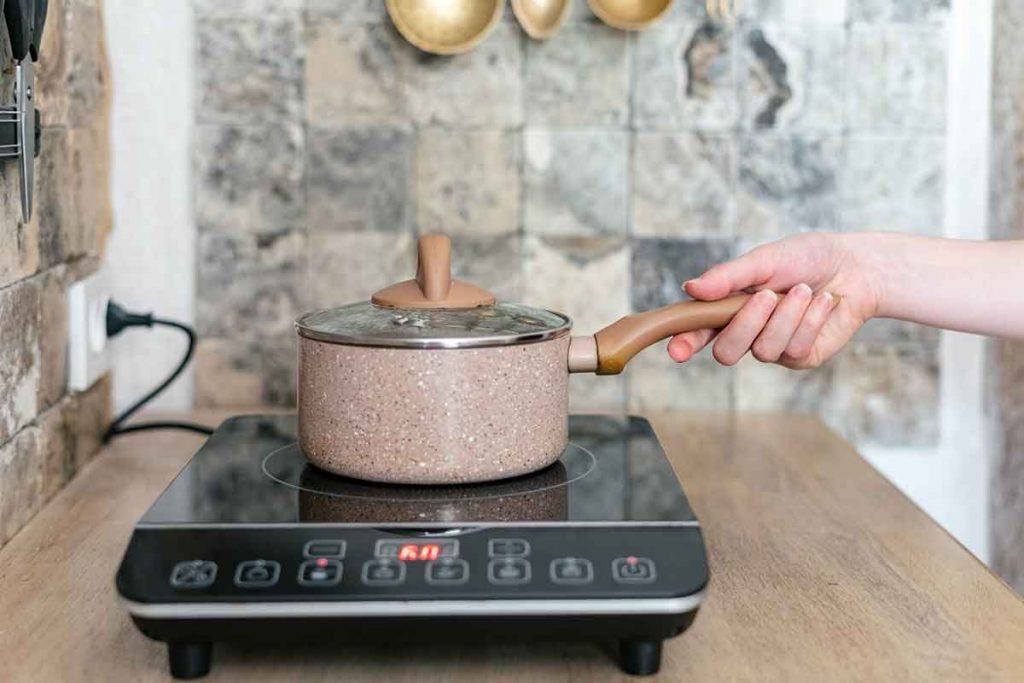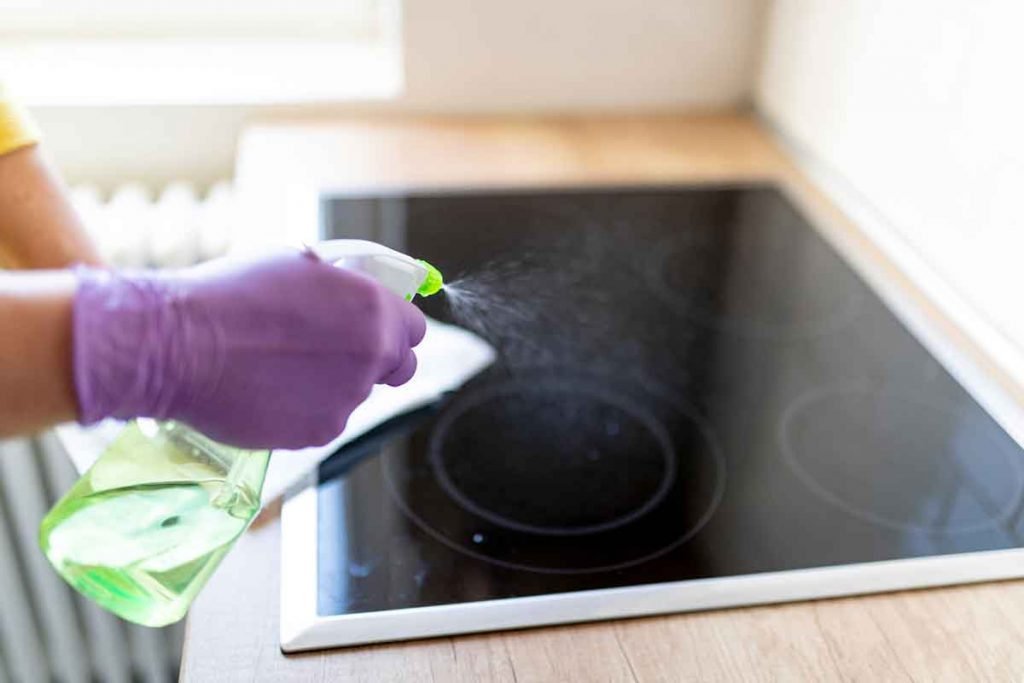Besides offering convenient cooking, induction cooktops have eliminated the need for gas and electric units. This flameless cooking alternative has reduced careless fire incidents that would otherwise be dangerous and life-threatening. But how safe are induction cooktops? Can they cause a fire? Read on as we delve into this common concern among induction cooktop users.
Can induction Cooktops Cause Fire?
Since their introduction, induction cooktops have been sold majorly based on energy efficiency and safety. How safe are induction cooktops?
For starters, the surface of induction cooktops does not get hot. It is, therefore, unlikely that you will burn a surrounding item.
There is minimal extra heat created from the burner, which always leaves your kitchen cool and ambient.
The source of heat is out of the picture once you remove the cookware from the cooktop. This then eliminates the risk of an accidental fire.
However, despite the convenience, a few factors, if not carefully considered, can increase the risk of an accidental fire. Here are three major factors that, if carelessly handled, could lead to an induction cooktop fire:
Your Choice of Cookware
Not all materials are suitable for induction cooking. Induction-compatible cookware must be ferromagnetic. A wrong choice of a cooking vessel may be risky and very hazardous. You can always check the compatibility of your cookware using a kitchen magnet. Just place a magnet at the bottom of the cookware. If it sticks, then your cookware is induction ready.
While at it, you should also consider the thermal property of your material. The higher the thermal heat efficiency, the better the cooking experience. Lastly, your cookware’s bottom and size is an important safety design elements. Small-sized or unevenly based cookware may affect heat distribution and serve as a safety inconvenience.
Your Choice of Fuel
Cooking oil is the commonly used fuel on an induction unit. However, three crucial features are considered when looking into suitable cooking oil: the smoke point temperature, fire point temperature, and flash point temperature.
The temperature of the oil heated up and giving off smoke is referred to as Smoke Point Temperature. The fire point temperature is the temperature at which heated oil sustains burning after being ignited by a flame, while the flash point temperature is the temperature of the heated oil that gives barn when exposed to a flame. Choose your cooking fuel keenly and carefully.
Your Induction Unit
As earlier mentioned, the main parts of an induction unit are the ceramic plate, control panel, and power cord. Out of this, the power cable is not fire-resistant and can easily be damaged. Additionally, improper use of an induction cooker can undoubtedly lead to it becoming a kitchen fire hazard.
You can, however, embed the following functions for enhanced safety:
Install a safety cut-off system to curb any instance of overheating.
Introduce an automatic shutdown feature. This feature will come in handy when cookware is removed from the induction cooktop and when the unit does not experience temperature/power change for a continuous 90 minutes period.
Introduce a feature that disenables power output once cookware is removed.
Install a fan/ventilation hood to prevent residual heat from accumulating inside the cooktop.
Keep inflammable and magnetic objects at a safe distance from the induction.
Can You Burn Yourself on an Induction Cooktop?
Typically, the induction cooktop doesn’t produce heat when no pan is placed on it. Before then, you can comfortably touch the unit. However, you are likely to suffer from burns if you place your hand on the cooktop surface immediately after removing a hot pan from it. The cooktop surface will retain some heat and will be hot enough to burn you.
What are the Benefits of Owning an Induction Cooktop?
Induction cooking is the easiest and quickest way of cooking. Induction cooktops are safe and easy to clean. The units are consistent and allow you to cook at different temperatures—something electric cooktops cannot do. Apart from that, they add beauty to a kitchen. They are indeed a good investment!
How Do Induction Cooktops Operate?
The major components of an induction cooktop are the glass-ceramic plate and heating element coil. What happens is that the current is passed to the copper coil once you switch on your power outlet. The current then generates a high-frequency magnetic field that penetrates the ferromagnetic cookware placed on top of the cooktop. An eddy current is generated as heat in the cookware is then transferred to the cookware contents.
Other Common Causes of Kitchen Injuries Are
- Putting food on the induction unit to cook but leaving them unattended
- Forgetting to turn the induction unit off after removing the cooking pan
- Undivided attention and miscalculation in cooking in terms of time and amount of heat required
- Placing kitchen towels and potholders too close to the heating element
- Allowing dirt and grease to build upon the cooktop’s surface
- Attempting to clean the cooktop while it is still hot
You can make the kitchen safer by settling on an induction cooktop that cools off fast to reduce the risk of burns and associated injuries. On the same note, an induction unit with color indicators would be a great choice. Through the indicators, you can easily tell when the burners are on and still hot.
Ensure that you wipe off spills (water, soup, sauce, oil, or milk) from the various kitchen surfaces, the induction cooktop countertop, and the floor. This reduces the possibility of a wide array of kitchen accidents and injuries.
Can I Leave the Stove on Low Overnight?
Induction cooktops are designed to run continuously. Induction cooktop manufacturers always test their units for thermal stability before releasing them to the market. This means that you can leave your induction stove on low overnight. Just ensure that your meal has sufficient fluid, as unattended cooking remains the leading cause of house fires!
The food will likely lose its flavor and texture by morning! This is in addition to the anxiety and uncertainty that the experience will draw.
FAQs
Do You Need A Hood for an Induction Cooktop?
Although Induction cooking creates less ambient heat, it wouldn’t harm to have a ventilation system. Ventilation removes residual heat, steam, grease, and smoke bound to be present as cooking by-products. Ventilating hoods come with air purification techniques that ensure the kitchen stays cooler. Additionally, ventilating hoods concentrate and trap grease, making cooking safer.
Some of the best ventilation hoods options are wall-mounted hoods, under-cabinet hoods, ceiling-mounted/ free-hanging hoods, and downdraft ventilation.
Tip: The hoods are stylish, and they tend to give the kitchen an aesthetic look.
Why Does My Induction Cooktop Keep Turning Off?
Your induction stove could be turning off due to the following reasons.
You are using Induction-Incompatible Cookware
Using non-ferrous cookware could be the reason why your induction unit keeps on turning off. Aluminum cooking vessels don’t detect the cooking implement in your unit, and this interference could be causing the unit to repeatedly turn off. Always use cast iron or steel pans when using induction cooktops.
Your Induction Plate has Insufficient Power
Different induction plates have additional power requirements. Some hobs are powered by single plates, while others are powered by multiple plates/rings. Depending on the power requirement of your unit, insufficient power would keep your unit from performing excellently. Always make sure that your Induction unit operates at optimum energy levels.
You Have a Problematic Power Board
The circuit board manages all your unit’s functions. A defect in the power board may be the reason why your induction cooktop is misbehaving. Conduct a thorough diagnosis on your power board and, where necessary, replace it.
Your Electrical Installation is Faulty
Poor electrical installation is one of the top reasons for problematic Induction cooktops. To be sure of this, check whether your hob is correctly connected to the socket. Ensure that the reading on your current flows is 230 volts. A reading below 230 volts would mean that your electricity isn’t correctly installed. You should also check whether your terminal connectors are properly tightened.
The Terminal Block Cables are Improperly Connected
The cables on the terminal can block the direct flow of electricity to the induction unit. Any form of interference in the connection may be the reason why your induction stove is repeatedly turning off. It is important to confirm whether the screws on the terminal block are properly tightened to correct this problem
You Have an Extensively Damaged or Burnt Terminal Block.
A damaged terminal block could be the root of your induction cooktop problems. Replace your terminal block, tighten all screws, and connect your earth wire properly to handle this problem.
Your Induction Has a Configuration Problem
An incorrectly configured hob would make the unit overheat, malfunction, or not work at all. It is, therefore, necessary to familiarize yourself with your wattage range before bringing your appliance home.
Induction cooktops rank among the safest cookers on the market today. If you take care and take the precautions highlighted above caution, you can safely use your Induction Cooktop for years to come. We hope you find this post helpful. Have a safe Induction cooking experience!



